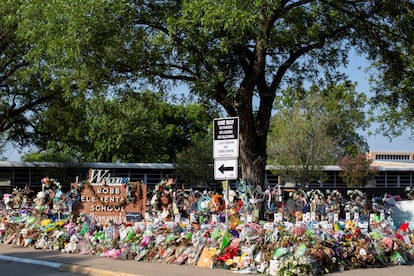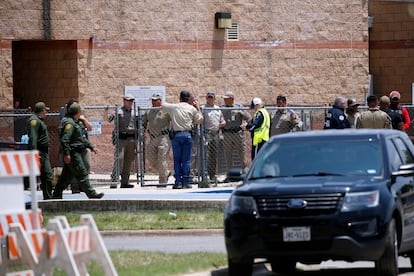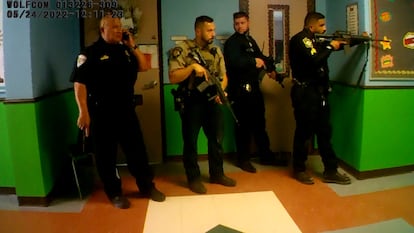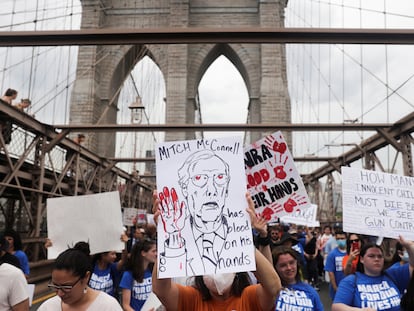Uvalde shooting report finds ‘systemic failures and egregiously poor decision making’
A Texas House committee has released the findings of its probe into the lack of swift action at an elementary school where a gunman killed 19 children and two teachers

A Texas House committee on Sunday published a report on the events that occurred at Robb Elementary School on May 24, when an 18-year-old entered the center with an AR-15 rifle and murdered 19 children and two teachers. It was the second worst school shooting in US history.
This report, two months in the making, seeks to answer persisting questions around the massacre. One of the conclusions is that everything failed that day, from the classroom doors that were not locked as they should have been, to the response by the 376 agents from various law enforcement agencies who responded to the emergency call. The report talks about “systemic failures and egregiously poor decision-making.”
The school
The tragedy began with three open doors. The lengthy report devotes significant space to a discussion of the chain of errors that allowed Salvador Ramos, who is never mentioned by name out of respect for the victims, to enter the school without resistance. The killer entered through the west campus gate. If school personnel had secured the doors, as required by protocol, this would have slowed his progress for a few valuable minutes in which the teachers and children could have been alerted, states the document.
Once inside, Ramos walked down the main hallway and turned left into Room 111, filled with fourth graders. This room connected from the inside with Room 112. According to the report, various administrators were aware that the lock was faulty, but no maintenance work had been ordered. “If the door to Room 111 had been locked, the attacker likely would have been slowed for some time as he either circumvented the lock or took some other alternative course of action,” says the report.

The investigation also notes that school administrators, teachers and law enforcement officials may have taken the lockdown alert less seriously than they should have, due to the fact that between February and May of this year, local authorities had issued 47 alerts at the school for a variety of reasons, including high-speed police chases of migrant smugglers on a road near the school.
Ramos’ first few minutes inside Robb Elementary were the deadliest. According to the investigation, of the 142 shots he fired inside the building, about 100 were fired in quick bursts during the first two and a half minutes, before the first policeman set foot inside the school. That round of fire caused the most casualties that day.
The police response
Much has been said about the response of the authorities. The document highlights the mistakes made by hundreds of agents who showed up at the scene. “Law enforcement responders failed to adhere to their active shooter training, and they failed to prioritize saving the lives of innocent victims over their own safety,” the document states. The authors describe as “unacceptable” the lengthy period of time it took for the police to enter Room 111 and shoot Ramos down.“ The report concludes that “it is plausible that some victims could have survived if they had not had to wait 73 additional minutes for rescue,” states the report.
While school police chief Pete Arrendondo is criticized for the way he responded to the crisis, he is not the only one to blame. “In this crisis, no responder seized the initiative to establish an incident command post,” notes the report, even though other officers on the scene with better training should have recognized “obvious deficiencies in command and control” and offered assistance.
The report also discusses the role of social media and the gunman’s family for failing to see the signs. Ultimately, the tragedy unfurled on the back of a series of errors. “There is no one to whom we can attribute malice or ill motives. Instead, we found systemic failures and egregiously poor decision making,” the report notes.

The report has caused a lot of anger among the victims’ relatives, who had been hearing for weeks about the chain of errors. “It’s a joke. They’re a joke. They’ve got no business wearing a badge. None of them do,” said Vincent Salazar, grandfather of 11-year-old Layla Salazer, on Sunday.
Tu suscripción se está usando en otro dispositivo
¿Quieres añadir otro usuario a tu suscripción?
Si continúas leyendo en este dispositivo, no se podrá leer en el otro.
FlechaTu suscripción se está usando en otro dispositivo y solo puedes acceder a EL PAÍS desde un dispositivo a la vez.
Si quieres compartir tu cuenta, cambia tu suscripción a la modalidad Premium, así podrás añadir otro usuario. Cada uno accederá con su propia cuenta de email, lo que os permitirá personalizar vuestra experiencia en EL PAÍS.
¿Tienes una suscripción de empresa? Accede aquí para contratar más cuentas.
En el caso de no saber quién está usando tu cuenta, te recomendamos cambiar tu contraseña aquí.
Si decides continuar compartiendo tu cuenta, este mensaje se mostrará en tu dispositivo y en el de la otra persona que está usando tu cuenta de forma indefinida, afectando a tu experiencia de lectura. Puedes consultar aquí los términos y condiciones de la suscripción digital.
More information
Archived In
Últimas noticias
Daytime, headphones, no booze involved: How a generation is saying ‘no’ to club parties
Millennia-old Yuracaré language resists extinction through 900 speakers and a new dictionary
Susan Boyle prepares a comeback just as Timothée Chalamet sings her praises
Trump suspends green card visa lottery after shooting at Brown University
Most viewed
- Christian Louboutin: ‘Young people don’t want to be like their parents. And if their parents wear sneakers, they’re going to look for something else’
- US sanctions against jailed cartel leader ‘El Marro’ highlight Mexico’s lack of control over its prisons
- Cartels in Mexico take a leap forward with narco-drones: ‘It is criminal groups that are leading the innovation race’
- Liset Menéndez de la Prida, neuroscientist: ‘It’s not normal to constantly seek pleasure; it’s important to be bored, to be calm’
- ‘El Limones’ and the growing union disguise of Mexican organized crime











































